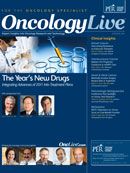Publication
Article
Oncology Live®
Pharmacogenomics in Action: CYP2D6 Breast Cancer Debate Shows Intricacies of Genotyping
Author(s):
Recently reported and truly impressive clinical trial data have revealed the relevance of administering antineoplastic agents specifically and prospectively targeted to molecular abnormalities.

Maurie Markman, MD
Editor-in-Chief of OncologyLive
Senior vice president for Clinical Affairs and National Director for Medical Oncology Cancer Treatment Centers of America, Eastern Regional Medical Center
Recently reported and truly impressive clinical trial data have revealed the relevance of administering antineoplastic agents specifically and prospectively targeted to molecular abnormalities within the cancers of individual patients. The justification for such an approach is based both on preclinical and clinical data that have revealed the relevance of the particular target in the disease setting.
Less frequently discussed, but potentially equally important in optimizing the ultimate efficacy and minimizing the toxicity of a therapeutic strategy, are genetically defined features within the individual patient’s normal, rather than tumor, molecular environment. Unfortunately, while this concept is attractive, it has been difficult to confirm the utility resulting from knowledge of unique genetic factors existing within the patient, even in settings where the clinical relevance of such relationships has been proposed based on solid preclinical or epidemiological considerations.
A prominent example of this situation is the intense investigation and surrounding controversy associated with a potential role for genetic variants of cytochrome P450 (CYP2D6) in influencing the metabolic fate and ultimate biological activity and clinical effectiveness of tamoxifen in the management of breast cancer. Studies from excellent investigative groups both supporting and rebutting the relevance of such genetic variation have been reported in the peer-reviewed literature.1 At the present time, it remains uncertain whether patients who poorly metabolize the parent compound to its active metabolites are less likely to achieve a favorable outcome compared with individuals who have the genetically defined apparatus to metabolize this agent extensively.
And, while the prognostic influence of the existence of specific cytochrome P450 genetic variants in defining the benefits of tamoxifen therapy in individual patients remains unclear, an even more unsettled question is the issue of whether pretherapy knowledge of the presence of such variations in a patient can be utilized to modify the planned therapy to favorably influence that outcome.
In a most provocative report designed to begin to address this issue, investigators genotyped 119 women receiving tamoxifen for a minimum of 4 months for the management of their breast cancer.2 The inclusion criteria also required that participants were not taking any medications known to inhibit CYP2D6.
Patients found to be genetically defined as intermediate or poor metabolizers of tamoxifen had the daily oral dose of this agent increased from 20 mg to 40 mg. (Of note, it is recognized that this higher dose of tamoxifen can be administered safely in this clinical setting.) Individuals identified as being extensive metabolizers had their dose remain at 20 mg per day.
The concept of using genetically defined features within the individual patient’s normal molecular environment to help guide therapy is attractive but not fully validated.
Serum levels of the highly biologically active tamoxifen metabolite endoxifen were measured both at baseline (prior to raising the dose) and approximately 4 months following the increase in tamoxifen dosing.
As expected, patients who were extensive metabolizers were found to have the highest baseline serum level of endoxifen, with lower levels observed in the intermediate group, and the lowest concentrations in the poor-metabolizing group.
The study revealed a substantial increase in the measured endoxifen concentration in both the intermediate- and poor-metabolizing populations. Of interest, following the increase in the tamoxifen dose, the concentration of endoxifen in the intermediate group increased to approximate the level attained in the population of extensive metabolizers treated with 20 mg per day. However, in the poor metabolizers, the concentration failed to reach the levels of this group despite the delivery of the 40-mg per day tamoxifen dose.
These data, while preliminary and requiring confirmation by others, suggest the potential for CYP2D6 genotyping to provide information of clinical relevance for breast cancer patients receiving tamoxifen in the adjuvant or metastatic disease settings. While it remains uncertain whether increasing the concentration of biologically active tamoxifen metabolites will improve the utility of therapy, a rational argument can certainly be advanced to support this hypothesis.
Finally, since cost-effective whole-genome sequencing of both cancer and normal tissue most likely will be widely available within the next several years, this type of patient-specific molecular information may be of considerable assistance to oncologists as they attempt to optimize clinical management.
References
- Lash TL, Rosenberg CL. Evidence and practice regarding the role for CYP2D6 inhibition in decisions about tamoxifen therapy. J Clin Oncol. 2010; 28(8):1273-1275.
- Irvin WJ Jr, Walko CM, Weck KE, et al. Genotype-guided tamoxifen dosing increases active metabolite exposure in women with reduced CYP2D6 metabolism: a multicenter study. J Clin Oncol. 2011; 29(24):3232- 3239.










